Related Research Articles

Augustinians are members of several religious orders that follow the Rule of Saint Augustine, written in about 400 AD by Augustine of Hippo. There are two distinct types of Augustinians in Catholic religious orders dating back to the 12th–13th centuries:
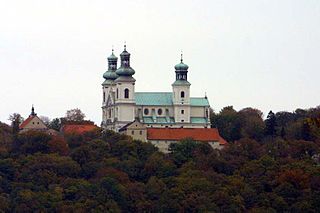
The Camaldolese Hermits of Mount Corona, commonly called Camaldolese, is a monastic order of Pontifical Right for men founded by Saint Romuald. Its name is derived from the Holy Hermitage of Camaldoli, high in the mountains of central Italy, near the city of Arezzo. Its members add the nominal letters E.C.M.C. after their names to indicate their membership in the congregation. Apart from the Roman Catholic monasteries, in recent times ecumenical Christian hermitages with a Camaldolese spirituality have arisen as well.
Devotio Moderna was a movement for religious reform, calling for apostolic renewal through the rediscovery of genuine pious practices such as humility, obedience, simplicity of life, and integration into the community. It began in the late 14th century, largely through the work of Gerard Groote, and flourished in the Low Countries and Germany in the 15th century, but came to an end with the Protestant Reformation. It is most known today through its influence on Thomas à Kempis, the author of The Imitation of Christ, a book which has proved highly influential for centuries.
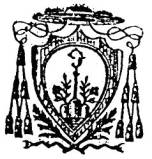
The Sylvestrines are a congregation of monks of the Order of St Benedict who form the Sylvestrine Congregation. The Sylvestrines use the post-nominal initials O.S.B. Silv.. The congregation was founded in 1231 by Sylvester Gozzolini. They are members of the Benedictine Confederation. The congregation is similar to others of eremitical origin, in that their houses are not raised to the status of an abbey, which would entangle the monasteries more strongly in the affairs of the world. The congregation, though, is led by an abbot general, the only abbot it has, who supervises all the houses of the congregation.

The Benedictine Confederation of the Order of Saint Benedict is the international governing body of the Order of Saint Benedict.
Canons regular are priests who live in community under a rule and are generally organised into religious orders, differing from both secular canons and other forms of religious life, such as clerics regular, designated by a partly similar terminology.
Independent Augustinian communities are Roman Catholic religious communities that follow the Augustinian Rule, but are not under the jurisdiction of the Prior General of the Augustinian hermits in Rome.
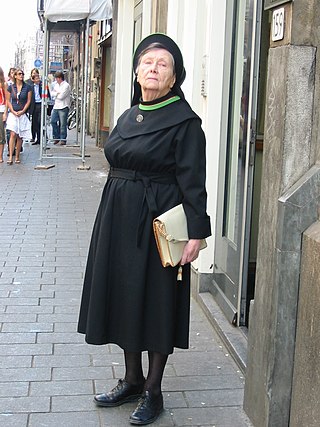
Augustinian nuns are the most ancient and continuous segment of the Roman Catholic Augustinian religious order under the canons of contemporary historical method. The Augustinian nuns, named after Saint Augustine of Hippo, are several Roman Catholic enclosed monastic communities of women living according to a guide to religious life known as the Rule of St. Augustine. Prominent Augustinian nuns include Italian mystic St. Clare of Montefalco and St. Rita of Cascia.
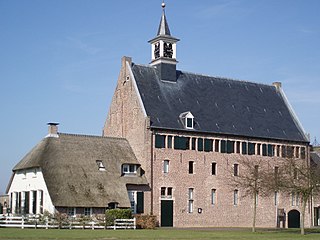
The Congregation of Windesheim is a congregation of Augustinian canons regular. It takes its name from its most important monastery, which was located at Windesheim, about four miles south of Zwolle on the IJssel, in the Netherlands.

Lawrence Justinian was a Venetian Catholic priest and bishop who became the first Patriarch of Venice. He is venerated as a saint by the Catholic Church.

The Madonna dell'Orto is a church in Venice, Italy, in the sestiere of Cannaregio. This was the home parish of Tintoretto and holds a number of his works as well as his tomb.

San Giorgio in Alga is an island of the Venetian lagoon, northern Italy, lying between the Giudecca and Fusina.
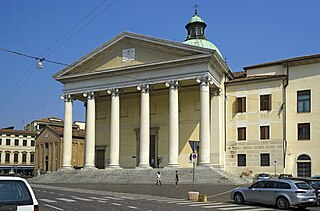
The Diocese of Treviso is Latin Church ecclesiastical territory or diocese of the Catholic Church in the Veneto, Italy. It is a suffragan diocese in the ecclesiastical province of the metropolitan Patriarchate of Venice.
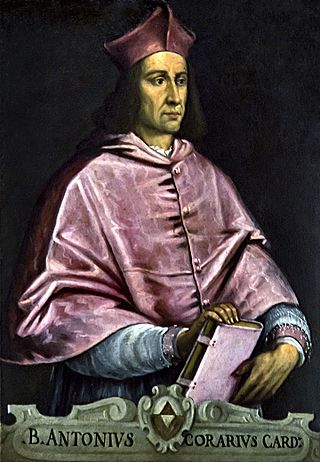
Antonio Correr was a Roman Catholic Cardinal who was appointed cardinal by his uncle Pope Gregory XII during the period of the Great Western Schism.

San Giorgio in Braida is a Roman Catholic church in Verona, region of Veneto, Italy. A church titled San Giacomo in Braida, was located in Cremona, and became superseded by Sant'Agostino.
Ludovico Barbo, O.S.B. (1381–1443), also referred to as Luigi Barbo, was a significant figure in the movement to reform monastic life in northern Italy during the 15th century. Originally a canon of the community which became the Canons Regular of San Giorgio in Alga, he died a Benedictine abbot and Bishop of Treviso (1437–1443).

Gabriele Sforza, was a member of the Augustinian Order who served as Archbishop of Milan from 1445 to his death in 1457.

The House of Correr or Corraro was a major patrician family in the history of the Republic of Venice. The family belonged to the Venetian nobility.

Supper in the House of Simon the Pharisee is a 1544 oil on canvas painting by Moretto da Brescia, now in the Chiesa della Pietà in Venice, Italy.
Giordano Forzatè, anglicized Jordan Forzatè, was a Paduan Benedictine monk and religious leader. For his noble background, peacemaking efforts and monastic reforms, the Chronicle of the Trevisan March calls him the pater Padue, "father of Padua".
References
- 1 2 3 4 5 "Canons of San Giorgio in Alga". Augustinians Canons. Archived from the original on 17 July 2012. Retrieved 16 February 2013.
- ↑ "Canons and Canonesses Regular". Catholic Encyclopedia.
- ↑ "Chiesa della Madonna dell'Orto", Religiana
- ↑ Bowd, Stephen D., Venice's Most Loyal City: Civic Identity in Renaissance Brescia, Harvard University Press, 2010, p. 96 ISBN 9780674060562
- ↑ "Storia". Abbazia S. Giustina (in Italian). Retrieved 10 October 2015.
- ↑
 This article incorporates text from a publication now in the public domain : Jackson, Samuel Macauley, ed. (1914). "Boni Homines". New Schaff–Herzog Encyclopedia of Religious Knowledge (third ed.). London and New York: Funk and Wagnalls.
This article incorporates text from a publication now in the public domain : Jackson, Samuel Macauley, ed. (1914). "Boni Homines". New Schaff–Herzog Encyclopedia of Religious Knowledge (third ed.). London and New York: Funk and Wagnalls.